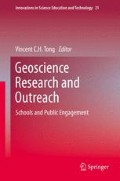Abstract
This chapter provides an overview of the last two decades’ European experiences in educational seismology and describes the different contexts in which they have been developed. The basic idea of these educational projects is that seismology may represent an efficient communication vehicle for teaching a wide range of basic earth science topics through laboratory practices and educational activities. Moreover, it is also an effective tool to raise in the young citizens the awareness on the earthquake risk and possible mitigation actions. In this frame, several seismic stations with different technologies were installed in schools across Europe. The scientific support of researchers and the need to establish strong links between teachers and researchers attribute to the school an active role in the knowledge process using the scientific laboratory practice by adopting the ‘learning by doing’ modern approach of science communication (R. Schank C. Cleary, 1995). Some educational activities correlated with seismological projects are presented, following different strategies depending on the country, but all aimed at building a new way to communicate science in the schools. The new vogue is the opening towards social media and blogs. This generalises the concept of an educational Geoscience website making it an e-platform for science communication and multimedia data sharing, where researchers, teachers, students and education operators can interact and constantly be kept informed of ongoing activities and relevant events.
Access this chapter
Tax calculation will be finalised at checkout
Purchases are for personal use only
References
Banchi, H., & Bell, R. (October 2008). The many levels of inquiry. Science and Children, 46(2), 26–29.
Berenguer, J. L., Courboulex, F., Le Puth, J., Zodmi, B., Bernard, P., Larroque, C., Matias, L., Moulié, F., Ngo, O., Nolet, G., Tartiere, M., Tilquin, F., & Virieux, J. (2009a). Feeling the Earth shake….at school Edusismo: The French educational seismological network. EMSC Newsletter, (24), 6–9.
Berenguer, J. L., Pascucci, F., & Ferry, H. (2009b). Le cahier d’activité du Sismo, v2. Editions du CRDP de Nice, 109 p.
Berenguer, J. L., Solarino, S., Courboulex, F., Ponzone, M., Cremonini, R., Eva, C., Eva, E., Ferretti, G., Leputh, J., Barroux, E., Sornette, A., Luyet, V., & Bosset, H. (2011). The O3E program: Innovative educational and communication tools for better face natural hazards and emergencies. Geophysical research abstracts, vol. 12, EGU2010-8623-2, EGU General Assembly 2010, Wien.
Bobbio, A., & Zollo, A. (2000). The educational broadband seismic network at Naples (Southern Italy). Orfeus Newsletter, 2(3), 23.
Bobbio, A., & Zollo, A. (2009). Toward a new way of thinking about educational seismology. EMSC Newsletter, (24), 22–23.
Bobbio, A., Cantore, L., Miranda, N., & Zollo, A. (2007). New tools for scientific learning in the EuSeis project: The e-learning experiment. Annals of Geophysics, 50(2), 283–290.
Bullen, S. (1998). Seismology in schools. Astronomy and Geophysics, 39(4), 25–26.
Camassi, R. (2006). Percorsi formativi per la riduzione del rischio: il progetto Edurisk (Open file report). INGV.
Cantore, L., Bobbio, A., Di Martino, F., Petrillo, A., Simini, M., & Zollo, A. (2003). The EduSeis project in Italy: A tool for training and awareness on the seismic risk. Seismological Research Letters, 74(5), 596–602.
Cantore, L., Zollo, A., Bobbio, A., De Martino, F., & Amodio, L. (2004). SISMALAB: A interactive laboratory for “learning by doing” in seismology and seismic risk. Orfeus Newsletter, 6(2), 8.
Cantore, L., Zollo, A., Bobbio, A., Di Martino, F., & Simini, M. (2005). In CUEN (Ed.), Il progetto EduSeis – Un triennio di esperienze didattiche in sismologia. Naples: CUEN.
Clarke, J. (1994). Pieces of the puzzle: The Jigsaw method. In S. SHARAN (Ed.), Handbook of cooperative learning methods (pp. 34–50). Westport: Greenwood Press.
Denton, P. (2008). Seismology in schools: 10 years on. Astronomy and Geophysics, 49(6), 6.13–6.14.
Denton, P. (2009). UK school seismology project. EMSC Newsletter, (24), 16–19.
Hall-Wallace, M., & Wallace, T. C., Jr. (1996). Seismologists and educational outreach. Seismological Research Letters, 67(5), 3–5.
Milne, J. (1888). Pendulum seismometers. Nature, 37, 570–571.
Nolet, G. (1993). A Volksseismometer. IRIS newsletter Spring 1993 10–11 http://www.iris.edu/hq/publications/newsletters/iris (2011).
Schank, R. C., & Cleary, C. (1995). Engines for education. Hillsdale, NJ: Lawrence Erlbaum Associates.
Solarino, S. (2009). Are educational initiatives in schools effectively contributing to prevention in Italy?. EMSC Newsletter, (24), 10–11.
Stahl, G., Koschmann, T., & Suthers, D. (2006). Computer-supported collaborative learning: An historical perspective. In R. K. Sawyer (Ed.), Cambridge handbook of the learning sciences (pp. 409–426). Cambridge: Cambridge University Press.
Steinberg, D., Phinney, R. (2000). Curriculum using real science data at the Princeton Earth Physics Project. American Astronomical Society, 197th AAS meeting, #54.12; Bulletin of the American Astronomical Society, 32, 1494.
Virieux, J. (2000). Educational seismological project: EDUSEIS. Seismological Research Letters, 71, 530–535.
Walker, J. (1979). How to build a simple seismograph to record earthquake waves at home. Scientific American, 241(1), 152–161.
Acknowledgments
The educational activities described in this paper have been developed, performed and partially funded in the framework of the EU projects NERA, REAKT and MATRIX.
Author information
Authors and Affiliations
Corresponding author
Editor information
Editors and Affiliations
Rights and permissions
Copyright information
© 2014 Springer Science+Business Media B.V.
About this chapter
Cite this chapter
Zollo, A. et al. (2014). The European Experience of Educational Seismology. In: Tong, V. (eds) Geoscience Research and Outreach. Innovations in Science Education and Technology, vol 21. Springer, Dordrecht. https://doi.org/10.1007/978-94-007-6943-4_10
Download citation
DOI: https://doi.org/10.1007/978-94-007-6943-4_10
Published:
Publisher Name: Springer, Dordrecht
Print ISBN: 978-94-007-6942-7
Online ISBN: 978-94-007-6943-4
eBook Packages: Humanities, Social Sciences and LawEducation (R0)

